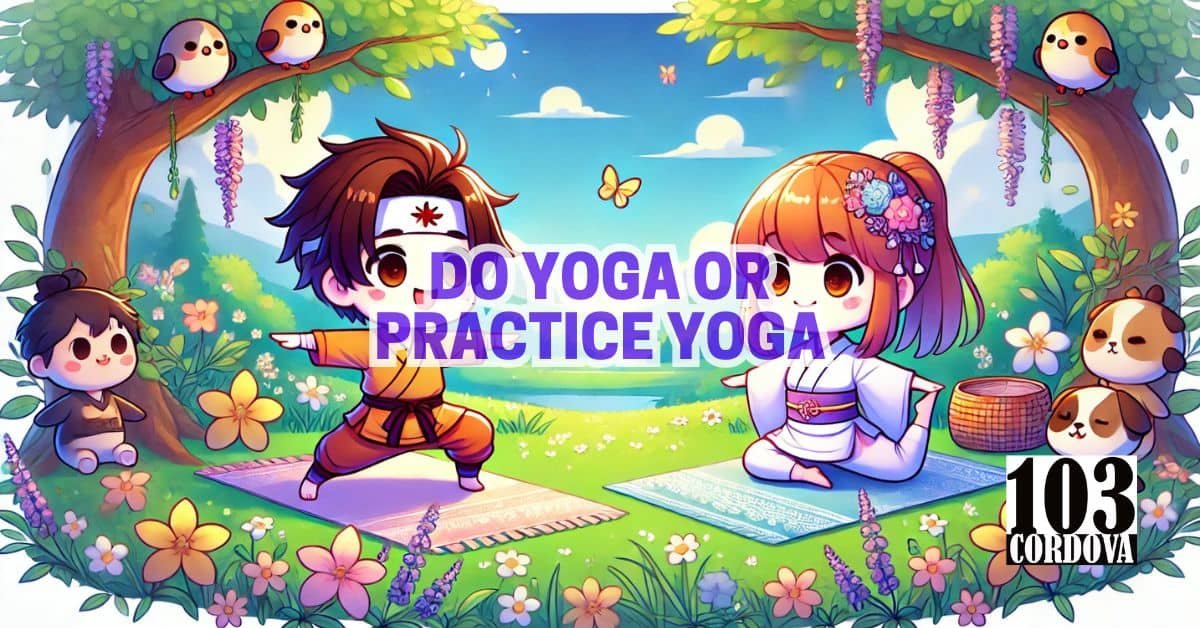When people talk about yoga, you might hear two different phrases: “do yoga” and “practice yoga.”
While these may sound similar, they actually reveal different ideas about what yoga means to individuals.
We’ll explore why people choose to say one phrase over the other and how it reflects their beliefs and experiences with yoga.
Understanding these differences can help us see how language shapes our relationship with yoga.
It also helps us respect each person’s unique approach to this ancient practice.
1. Understanding the Difference Between “Do Yoga” and “Practice Yoga”
“Do yoga” sounds like an activity you perform or complete, similar to going for a run or doing a workout.
It suggests a sense of finishing something and then moving on to the next task.
On the other hand, “practice yoga” implies an ongoing effort, a process of learning that has no final endpoint.
This word choice highlights a deeper commitment to yoga as an evolving journey.
The words we use reflect whether we view yoga as just another exercise or a meaningful, lifelong practice.
🧘 Kriya Yoga Vs. Kundalini Yoga: Understanding the Key Differences Between These Two Practices
2. How Culture and Language Influence Yoga Terminology
Culture and language significantly affect how we talk about yoga.
In Western culture, yoga is often viewed as a physical fitness activity, which is why “do yoga” is a more common phrase.
On the other hand, in cultures that see yoga as a spiritual tradition, the term “practice yoga” is used to emphasize dedication, personal growth, and mindfulness.
Language choices mirror our cultural experiences and the value we assign to yoga.
Understanding these cultural influences helps explain why people use different terms to describe their yoga experience.
🧘 Surprising Benefits of Gomukhasana Yoga for Your Health
3. Yoga as Exercise vs. Yoga as a Lifestyle: The Language Difference
Some people view yoga primarily as a form of exercise that keeps the body strong and flexible.
For them, saying “do yoga” fits because it feels like an activity that starts and ends, similar to a workout routine.
However, others see yoga as much more than a physical activity—it’s a lifestyle that includes breathing techniques, meditation, and ethical principles.
To these people, “practice yoga” feels more appropriate because it signifies an ongoing journey.
This language difference highlights whether yoga is seen as a task to be completed or a way of living.
🧘 Vinyasa Yoga Vs. Yin Yoga: Understanding the Differences and Finding Your Ideal Practice
4. The Evolution of Yoga Language in the Western World
The way people in the Western world talk about yoga has changed over time.
When yoga first gained popularity in the West, it was often promoted as a new fitness trend, which led to the widespread use of the term “do yoga.”
As more people began to understand the mental, emotional, and spiritual benefits of yoga, the term “practice yoga” started to become more common.
This shift in language shows an evolving appreciation for the broader aspects of yoga.
The evolution of these terms mirrors how Western society has gone from seeing yoga purely as exercise to understanding its deeper, more holistic aspects.
🧘 Why Every New Parent Should Consider the Benefits of Baby Yoga
5. Casual vs. Devotional Approaches: The Words We Use to Describe Yoga
The phrase “do yoga” often suggests a casual approach—something done occasionally for physical benefits or relaxation.
It might be something you fit into your schedule when you have the time, like a hobby.
In contrast, “practice yoga” implies a more devotional approach, where yoga is a regular part of life and a means for ongoing personal growth.
This devotion suggests a deeper bond with yoga, extending beyond just physical exercise.
The way we describe yoga reflects how serious or casual our relationship with it really is.
🧘 How the Benefits of Sarvangasana Yoga Can Transform Your Mind and Body
6. Why “Practice” Emphasizes Yoga’s Mindfulness and Spirituality
The term “practice” is closely linked with activities that require patience, learning, and mindfulness.
When people say “practice yoga,” they emphasize that it is about more than just physical movement—it’s also about improving mental focus and cultivating inner peace.
The word “practice” implies that there is always room for growth and that yoga is a continuous journey of self-discovery.
It also reflects the spiritual aspect of yoga, encouraging people to engage deeply with its teachings.
Using “practice” instead of “do” highlights the idea that yoga is about becoming a better version of oneself, both physically and spiritually.
🧘 How the Benefits of Handstand Yoga can Boost Your Confidence and Health
7. The Global Influence on How We Talk About Yoga
Yoga’s journey from its origins in India to the rest of the world has had a huge influence on the language used to describe it.
In India, yoga has traditionally been seen as a practice that involves discipline, mindfulness, and spiritual growth, which is why the word “practice” is often used.
As yoga spread to other countries, especially in the West, it became popular mainly for its physical health benefits.
This led to people saying “do yoga” because they viewed it as a workout.
The global spread of yoga has led to different interpretations, which is why the language we use to describe it varies so much from place to place.
🧘 The Surprising Benefits of Paschimottanasana Yoga
8. How Yoga Teachers and Media Shape the Language of Yoga
Yoga teachers and the media play a significant role in shaping how people perceive and talk about yoga.
Teachers who focus on yoga’s physical benefits often use the phrase “do yoga” to attract those interested in fitness.
Meanwhile, teachers who value yoga’s mental and spiritual benefits tend to use “practice yoga” to help students understand the depth of the discipline.
Media outlets, from magazines to social media influencers, also influence these perceptions by choosing the language that best fits their audience.
The words used by teachers and media have a strong impact on how newcomers approach yoga and what they expect from it.
🧘 Exploring the Surprising Benefits of Goat Yoga for Stress Relief
9. The Psychological Impact of Saying “Do Yoga” vs. “Practice Yoga”
The language we use has a psychological impact on how we think and feel about yoga.
Saying “do yoga” can make it feel like just another task on a to-do list, something you can complete and move on from.
On the other hand, “practice yoga” implies a long-term commitment, encouraging patience and ongoing effort.
This shift in mindset can affect how people view their progress in yoga—whether they focus on immediate results or gradual growth.
The difference in words can influence whether yoga feels like a temporary activity or a meaningful part of one’s life.
10. How Language Affects Our Perception of Yoga’s Depth and Meaning
The words we use to describe yoga shape how we perceive its depth and meaning.
When we say “do yoga,” it can make yoga sound like a simple physical exercise, focusing mainly on stretching and strength.
However, saying “practice yoga” suggests that it includes mental and spiritual aspects, encouraging us to explore beyond the physical poses.
The word “practice” opens up the possibility of continual learning, both on and off the mat.
This difference in language can shape whether we see yoga as a quick workout or as a comprehensive tool for improving our overall well-being.
💡 Conclusion
The language we use—”do yoga” or “practice yoga”—can reveal a lot about our relationship with yoga.
For some, yoga is a form of physical exercise that supports fitness and health, making the term “do yoga” feel fitting.
For others, yoga is a lifelong journey of self-discovery and mindfulness, and “practice yoga” better represents that experience.
By understanding these different phrases, we can reflect on what yoga means to us and how it fits into our lives.
The words we choose are important, as they shape our understanding and experience of this ancient practice.
🧘 Our Services
Discover balance and wellness with our Yoga Classes for All Ages, located at 103 Cordova Tower, Marquinton Residences, Cirma Street, Sto. Niño, Marikina City.
Whether you’re a beginner or experienced yogi, we offer personalized sessions to suit your needs.
Connect with a community that nurtures both body and mind in a welcoming and serene environment.
For inquiries, reach out via Facebook, our site’s contact form, or call us at 09176225780.
Start your journey to a healthier, more mindful you today!

